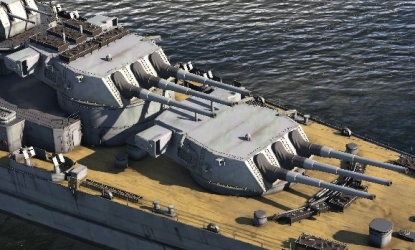12-inch/50 Mark 8 (305 mm)
Contents
Description
The 12-inch/50 Mark 8 is a 305 mm naval gun that was developed by the United States Navy in the early 1900s. It was first installed on the USS South Carolina, a pre-dreadnought battleship that was commissioned in 1910. The gun was highly regarded for its accuracy and power, and was used in a variety of combat scenarios, including in the Pacific Theater of World War II.
Vehicles equipped with this weapon
General info
The gun fires 305 mm rounds at a maximum range of over 24 km and could fire up to 2 rounds per minute.
Available ammunition
| Penetration statistics | |||||||
|---|---|---|---|---|---|---|---|
| Ammunition | Type of warhead |
Penetration @ 0° Angle of Attack (mm) | |||||
| 1,000 m | 2,500 m | 5,000 m | 7,500 m | 10,000 m | 15,000 m | ||
| Mk.17 HC | HE | 68 | 68 | 68 | 68 | 68 | 68 |
| Mk.18 AP | APCBC | 621 | 582 | 524 | 475 | 434 | 374 |
| Shell details | ||||||||||||
|---|---|---|---|---|---|---|---|---|---|---|---|---|
| Ammunition | Type of warhead |
Velocity (m/s) |
Projectile mass (kg) |
Fuse delay (s) |
Fuse sensitivity (mm) |
Explosive mass (TNT equivalent) (kg) |
Ricochet | |||||
| 0% | 50% | 100% | ||||||||||
| Mk.17 HC | HE | 808 | 426.38 | 0 | 0.1 | 35.31 | 79° | 80° | 81° | |||
| Mk.18 AP | APCBC | 762 | 517 | 0.035 | 17 | 7.73 | 48° | 63° | 71° | |||
Comparison with analogues
Give a comparative description of cannons/machine guns that have firepower equal to this weapon.
Usage in battles
Describe the cannon/machine gun in the game - its distinctive features, tactics of usage against notable opponents. Please don't write a "guide" - do not impose a single point of view, but give the reader food for thought.
Pros and cons
Summarise and briefly evaluate the weaponry in terms of its characteristics and combat effectiveness. Mark pros and cons as a list.
Pros:
Cons:
History
After the Wyoming-class dreadnoughts were completed in 1912, the United States Navy halted construction of 12-inch guns in favour of larger 14-inch and later 16-inch guns for their battleships. However, they began to re-evaluate their naval forces after the rise of German "pocket battleships" such as the Admiral Graf Spee and Scharnhorst along with the planned Japanese B-65 which were all designed to counter the 8-inch gun heavy cruisers codified by the 1922 Washington Naval Treaty. As a result, the United States began construction of what became the Alaska-class large cruiser to counter these threats. The 12-inch was thus revived as the 12-inch/50 Mark 8. Designed to fire a new armour-piercing "super heavy" shell to better penetrate deck armour while retaining side plate penetration capabilities, this gun had superior characteristics to the pre-Treaty 14-inch guns. The 12"/50 Mark 8 was only used on the USS Alaska and USS Guam.
Media
Excellent additions to the article would be video guides, screenshots from the game, and photos.
See also
Links to the articles on the War Thunder Wiki that you think will be useful for the reader, for example:
- reference to the article about the variant of the cannon/machine gun;
- references to approximate analogues by other nations and research trees.
External links
| USA naval cannons | |
|---|---|
| 20 mm | 20 mm/70 Oerlikon Mk.II · 20 mm/70 Oerlikon Mark V · 20 mm/70 Oerlikon Mark 24 |
| 25 mm | 25 mm/87 Mk.38 |
| 28 mm | 1.1 inch/75 Mk.1 |
| 37 mm | AN-M4 |
| 40 mm | Bofors L/60 Mark 1 · Bofors L/60 Mark 2 · Bofors L/60 Mark 3 |
| 76 mm | 3 inch/23 Mk.4 · 3-inch/50 Mk.10 · 3-inch/70 Mk.37 · 3-inch Mark 10 · 3 inch Mk.33 · 3-inch Mk.34 |
| 102 mm | 4 inch/50 Mk.9 |
| 127 mm | 5 inch/25 Mk.11 · 5 inch/25 Mk.13 AA · 5 inch/38 Mk.12 · 5-inch/50 Mk.5 · 5 inch/51 Mk.7 · 127 mm/54 Mark 18 |
| 152 mm | 6 inch/47 Mk.16 · 6 inch/47 DP Mk.16 · 6 inch/53 Mk.12 · M81 |
| 203 mm | 8 inch/55 Mark 9 · 8 inch/55 Mark 12 · 8 inch/55 Mark 14 · 8 inch/55 Mark 16 |
| 305 mm | 12-inch/45 Mk.5 · 12 inch/50 Mk.7 · 12 inch/50 Mk.8 |
| 356 mm | 14 inch/45 Mk.8 · 14 inch/45 Mk.12 · 14 inch/50 Mk.11 |




